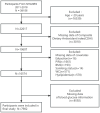Association between dietary antioxidant levels and diabetes: a cross-sectional study
- PMID: 39507906
- PMCID: PMC11539854
- DOI: 10.3389/fnut.2024.1478815
Association between dietary antioxidant levels and diabetes: a cross-sectional study
Abstract
Background: The onset and progression of diabetes mellitus (DM) is strongly linked to oxidative stress. Previous studies have highlighted the protective effects of individual dietary antioxidants against diabetes. However, the relationship between a comprehensive combination of dietary antioxidants and diabetes has rarely been examined. Therefore, this study assessed the association between various dietary antioxidant intake levels and diabetes among US adults and further investigated potential associations using the Composite Dietary Antioxidant Index (CDAI).
Methods: The study employed data from the National Health and Nutrition Examination Survey (NHANES) conducted between 2011 and 2018 for cross-sectional analysis. Dietary information was obtained from two 24-h dietary recall interviews. The CDAI was calculated using intakes of six dietary antioxidants from the dietary information. Multifactorial logistic regression models were employed to investigate the association of different dietary antioxidants and CDAI with DM. The relationship between CDAI and DM was further explored using subgroup analyses and restricted cubic spline curves.
Results: A total of 7,982 subjects (mean age 47.32 ± 16.77 years; 48.50% male and 51.50% female) were included in this study. In the multivariate-adjusted single antioxidant model, vitamin C intake was significantly and negatively associated with diabetes prevalence (P for trend = 0.047), while zinc intake demonstrated a potential trend toward reduced diabetes risk (P for trend = 0.088). This association was similarly observed in the multivariate-adjusted model for the Composite Dietary Antioxidant Index (CDAI) in the female population (p = 0.046).
Conclusion: Intake of vitamin C was negatively associated with DM prevalence. Additionally, CDAI was found to reduce the risk of DM in the female population.
Keywords: NHANES; composite dietary antioxidant index; diabetes mellitus; dietary antioxidant; oxidative stress.
Copyright © 2024 Zhou, Xu, Li, Zhang and Xie.
Conflict of interest statement
The authors declare that the research was conducted in the absence of any commercial or financial relationships that could be construed as a potential conflict of interest.
Figures
Similar articles
-
Association between composite dietary antioxidant index and kidney stone prevalence in adults: data from National Health and Nutrition Examination Survey (NHANES, 2007-2018).Front Nutr. 2024 May 22;11:1389714. doi: 10.3389/fnut.2024.1389714. eCollection 2024. Front Nutr. 2024. PMID: 38840700 Free PMC article.
-
Bone mineral density is associated with composite dietary antioxidant index among US adults: results from NHANES.Osteoporos Int. 2023 Dec;34(12):2101-2110. doi: 10.1007/s00198-023-06901-9. Epub 2023 Sep 4. Osteoporos Int. 2023. PMID: 37666910
-
Association between different composite dietary antioxidant indexes and low back pain in American women adults: a cross-sectional study from NHANES.BMC Public Health. 2024 Jan 10;24(1):147. doi: 10.1186/s12889-024-17649-0. BMC Public Health. 2024. PMID: 38200420 Free PMC article.
-
Association between composite dietary antioxidant index and epilepsy in American population: a cross-sectional study from NHANES.BMC Public Health. 2024 Aug 17;24(1):2240. doi: 10.1186/s12889-024-19794-y. BMC Public Health. 2024. PMID: 39154181 Free PMC article.
-
Dose-response relationship between dietary antioxidant intake and diabetic kidney disease in the US adults with diabetes.Acta Diabetol. 2023 Oct;60(10):1365-1375. doi: 10.1007/s00592-023-02125-9. Epub 2023 Jun 22. Acta Diabetol. 2023. PMID: 37347448
Cited by
-
The contribution of dietary total antioxidant capacity to type 2 diabetes risk and levels of glycemic biomarkers: a systematic review.Osong Public Health Res Perspect. 2025 Apr;16(2):100-115. doi: 10.24171/j.phrp.2024.0337. Epub 2025 Mar 27. Osong Public Health Res Perspect. 2025. PMID: 40139760 Free PMC article.
-
Association between the dietary index for gut microbiota and diabetes: the mediating role of phenotypic age and body mass index.Front Nutr. 2025 Jan 22;12:1519346. doi: 10.3389/fnut.2025.1519346. eCollection 2025. Front Nutr. 2025. PMID: 39911810 Free PMC article.
-
Association between the composite dietary antioxidant index and cardiovascular-kidney-metabolic syndrome among U.S. adults: evidence from NHANES 2007-2018.Front Nutr. 2025 Jul 10;12:1600651. doi: 10.3389/fnut.2025.1600651. eCollection 2025. Front Nutr. 2025. PMID: 40709338 Free PMC article.
-
Association of sarcopenia index, based on serum creatinine and cystatin C, with incident diabetes mellitus.Eur J Med Res. 2025 Mar 4;30(1):151. doi: 10.1186/s40001-025-02405-w. Eur J Med Res. 2025. PMID: 40033441 Free PMC article.
References
-
- Available at: https://diabetesatlas.org/atlas/tenth-edition/ (Accessed May 6, 2024).
LinkOut - more resources
Full Text Sources




